Telangana SCERT 10th Class Physics Study Material Telangana 5th Lesson Human Eye and Colourful World Textbook Questions and Answers.
TS 10th Class Physical Science 5th Lesson Questions and Answers Human Eye and Colourful World
Improve Your Learning
I. Reflections on concepts
Question 1.
How do you correct the eye detect Myopia?
(OR)
Explain the Myopia using the diagram.
Answer:
1. Some people cannot see objects at long distances but can see nearby objects clearly. This type of defect In vision is called ‘Myopia’ or ‘near sightedness’.

2. Myopia is corrected by using a concave lens of focal length equal to the distance of the far point F from the eye.
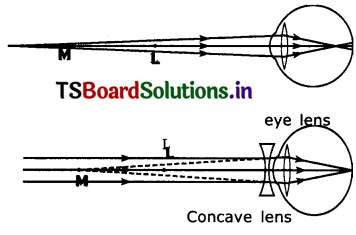
3. This lens diverges the parallel rays from distant objects as If they are coming from the far point.
4. Finally the eye lens forms a clear image at the retina.
5. Here object distance (u) is infinity and image distance (v) is equal to the far point, u = ∞, v distance of far point = – D, f = focal length of bi-concave lens.
We know = \( \frac{1}{f}=\frac{1}{v}-\frac{1}{u} \Rightarrow \frac{1}{f}=-\frac{1}{d}\)
⇒ f = -D
Here ‘f’ is negative showing that it is a concave lens.
Question 2.
Explain the correction of the eye detect Hypermetropia.
(OR)
Explain the Hypermetropia with the help of diagrams.
Answer:
1. A person with hypermetropia can see distant objects clearly but cannot see objects at near distances. This is also known as ‘far-sightedness’.
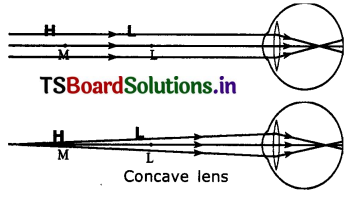
2. Eye lens can form a clear Image on the retina when any object Is placed beyond near point.
3. To correct the defect of hypermetropia, we need to use a lens which forms an image of an object beyond near point at H when the object is between H and L. This is possible only when a double convex lens is used.
4. The image acts like an object for the eye lens. Hence final Image to eye is formed at retina.
Here object distance (u) = – 25 cm
Image distance (v) distance of near point = – d.
f is the focal length of bi-convex lens.
we \(\frac{1}{f}=\frac{1}{v}-\frac{1}{u} \Rightarrow \frac{1}{f}=\frac{1}{-d}-\frac{1}{-25} \Rightarrow \frac{1}{f}=\frac{1}{-d}+\frac{1}{25} \Rightarrow \frac{1}{f}=\frac{d-25}{25 d} \)
5) If d > 25, then f becomes positive, It indicates that we need to use biconvex lens.
![]()
Question 3.
How do you find experimentally the refractive index of material of a prism?
Answer:
Aim: To find the refractive index of material of e-prism.
Material required: Prism, piece of white chart, pencil, pens, scale and protractor.
Procedure:
1. Take a prism and place it on the white chart in such a way that the triangular base of the prism is on the chart.
2. Draw a line around the prism base using pencil. Remove the prism and name the vertices of the triangle so formed as P, Q and R.
3. Measure the angle between PQ and PR. This Is the angle of the prism (A).
4. Mark M on the side PQ of PQR and also draw a perpendicular to PQ at M.
5. Draw a line with 300 to the normal at M. This line denotes the incident ray.
Note this value n the table.
| Angle of incidence (i1) | Angle of emergence(i2) | Angle of deviation (d) |
6. Place the prism In Its position (Δle) again.
7. Now fix two pins vertically on the line at the points A and B.
8. Look for the images of pins through the prism from the other side (PR) and fix another two pins at points C and D in such a way that all the four pins appear to lie along the same straight line.
9. Now remove the prism and take out pins.
10. Draw a line joining C and D and extend it to meet PR at N. This is the emerging ray.
11. Draw a normal to PR at N.
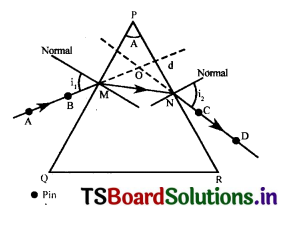
12. The angle between the normal at N and emergent ray Is the angle of emergence. Measure this angle and note its value in the above table.
13. Now join the points M and N by a straight line. The line passing through A, B, M, N, C and D represents the path of light when it suffers refraction through the prism.
14. Extend both incident arid emergence rays till they meet at ‘O’.
15. Measure angle between MO and ON, This is the angle of deviation, denoted by ‘d’. Note this value ¡n the table.
16. Repeat the process for different angles of incidence and measure corresponding angles of deviation.
17. Take angle of incidence along X-axis and the angle of deviation along Y-axis, draw a graph. D
18. We obtain a curve.
19. Draw a tangent line to the curve, parallel to X – axis, at the lowest point of the graph. The point where this line cuts.
Y – axis gives the angle of minimum deviation (D)
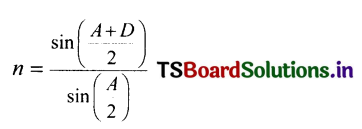
20. The refractive Index of prism
21. Using this formula, we can measure the refractive Index of the material of the prism.
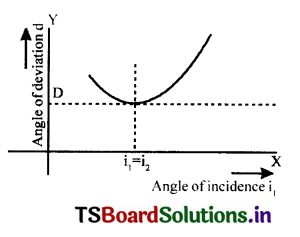
Question 4.
Explain the formation of rainbow.
(OR)
Explain the formation of rainbow with the help of water drop diagram.
Answer:
- Rainbow: The rainbow is an arch of seven colours visible in the sky which is produced by the dispersion of sun’s light by raindrops in the atmosphere.
- Observe the figure. The rays of sunlight enter the drop near its top surface.
- At this first refraction, the white light Is dispersed into its spectrum of colours, violet being deviated the most and red the least.
- Reaching the opposite side of the drop, each colour is reflected back into the drop because of total internal reflection.
- Arriving at the surface of the drop, each colour is again refracted into air.
- At the second refraction, the angle between red and violet rays further increases when compared to the angle between those at first refraction.
- We observe bright rainbow when the angle between incoming and outgoing rays is near the maximum angle of 42°.
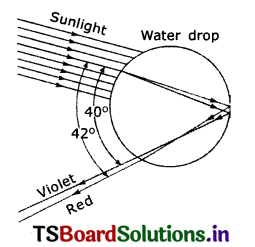
Question 5.
Explain two activities for the formation of artificial rainbow.
Answer:
ActivIty – 1:
- Take a metal tray and fill It with water.
- Place a mirror in the water such that it makes an angle to the water surface.
- Now focus white light on the mirror through the water as shown ¡n the figure.
- Try to obtain colours on a white card board sheet kept above the water surface.
- We can observe the seven colours of VISGYOR on the cardboard sheet.
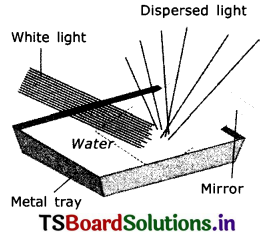
Activity – 2:
- Select a white-coloured wall on which the sun rays fall.
- Stand in front of a wall in such a way that the sun rays fall on your back.
- Hold a tube through which water is flowing.
- Place your finger in the tube to obstruct the flow of water.
- Water comes Out through the small gaps between the tube and your finger like a fountain.
- Observe the changes on the wall while the water shower is maintained.
- We observe different colours on the wall, which are similar colours of VIBGYOR.
![]()
Question 6.
Light of wavelength λ1 enters a medium with refractive Index n2 from a medium with refractive index n1 What is the wavelength of light In second medium?
Answer:
Speed of light v = nλ
if light can travel from one medium to second medium v1 = v2
n1λ1 = n2λ2
λ2 = \(\frac{n_1 \lambda_1}{n_1} \)
Question 7.
Why does the sky sometimes appear white?
Answer:
Our atmosphere contains atoms and molecules of different sizes. According to their sizes, they are able to scatter different wavelengths of light. For example, the size of the water molecules is greater than the size of the N, or 02 in air. It acts as a scattering centre for other frequencies which are lower than the frequency cf blue light.
On a “hot day due to rise in the temperature, water vapour enters into atmosphere which leads to abundant presence of water molecules in atmosphere. These water molecules scatter the colours of other frequencies. All such colours of other frequencies reaches our eye and mix together to give white colours.
Question 8.
A person is viewing an extended object. If a converging lens Is placed in front of his eye, will he feel that the size of object has increased? Why?
Answer:
- The person feels that the size of object has increased.
- He used the converging lens, i.e., the convex lens and the image s an extended object.
- This image is formed when the object is in between foci (f) and lens centre (p) of the lens.
- Hence the image size seems to be increased.
Question 9.
Explain briefly the reason for the blue colour of the sky.
Answer:
- Scattering of sunlight through molecules of atmosphere is the reason for the blue of the sky.
- Our atmosphere contains atoms and molecules of different sizes.
- According to their sizes they are able to scatter different wavelengths of light.
- For example, the size of the water molecule is greater than the size of the N2 or O2.
- It acts as scattering centre for other frequencies which are lower than the frequency of blue light.
Question 10.
Derive an expression for the refractive index of the material of a prism.
(OR)
Derive the formula for refractive index of a prsim.
Answer:
Observe the ray diagram in the figure.
[d is the exterior angle of ΔOMN. Exterior angle is equal to the sum of interior opposite angles.]
From ΔOMN, we get
d = i1 – r1 + i2 – r2 ………………………… (1)
From ΔPMN, We have
A+(90°-r1)+(90°-r2)= 180°
A+ 180°- (r1 + r2) = 180°
A=r1+r2 ……………………………… (2)
From (1) and (2) d= i1 + i2 — A
⇒ A+d=i1+i2 ……………………….. (3)
From Sneil’s law we know that n1 sin i = n2 sin r.
Using Snell’s law at M, with refractive index of air.
n1 = 1; i = i1; n2= n; r= r1
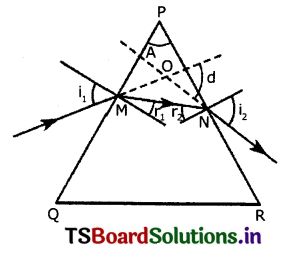
∴ sin i1 = n sin r1 ………………………. (4)
Similarly at N, with n1 = n; i = r2; n2 = 1; r = i2
∴ n sin r2 = sin i2 ………………………… (5)
We know that at the angle of minimum deviation (D), i1 = i2 ⇒ MN || QR
When i1 = i2 angle of deviation (d) becomes angle of minimum deviation (D).
∴ (3) ⇒ A +D = 2i1 ⇒ i1 = \(\frac{A+D}{2} \)
When i1 = i2 then it is clear that r1 = r2
∴ (2) ⇒ 2r1 ⇒ ⇒ r1 = \(\frac{A}{2} \)
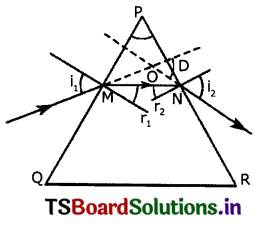
Substitute and r1 in (4), we get sin\(\left(\frac{A+D}{2}\right) \) = nsin\(\left(\frac{A}{2}\right) \)
where ‘r s the refractive index of the material of the prism.

Application of Concepts
Question 1.
indent ray on one of the face (AB) of a prism and emergent ray from the tace AC are given In figure. Complete the ray diagram.
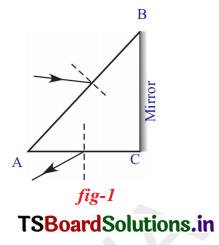
Answer:
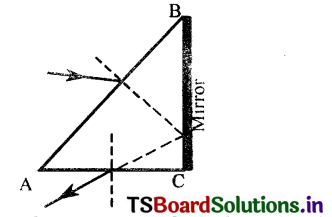
Question 2.
Glass is known to be transparent material. But ground glass is opaque and white in colour. Why?
Answer:
- Glass is generally a transparent material because it transmits most of the light incident on it.
- When glass Is at ground it’s surface becomes rough due to microscopic unevenness.
- When light is incident on such a rough surface, it is reflected in many (different) directions.
- This type of reflection is known as defeat reflection. Due to this ground glass is opaque (does not transmit high) and white in colour.
![]()
Question 3.
A light ray falls on one of the faces of a prism at an angle 40° so that It suffers angle of minimum deviation of 30°. Find the angle of prism and angle of refraction at the given surface.
Answer:
i = 400, D = 30°
At angle of minimum deviation i1 = i2 = i; r1 = r2 = r
i1 + i2= A+D
hence 2i =A+D
2(40°) = A + 30°
80-30 = A
The angle of the prism A = 50°
r1+ r2 = A
2r =A
r = A/2
∴ angle of refraction r= \(\frac{50^{\circ}}{2}\)
∴ r = 25°
Question 4.
The focal length of a lens suggested to a person with Hypermetropia is 100cm. Find the distance of near point and power of the lens.
Answer:
1. Distance of near point:
If ‘f’ is the local length and ‘d’ is the distance of near point then
f = \(\frac{25 d}{d-25} \)
(Recall f should be In cm)
Here, focal length f = 100cm
∴ 100 = \(\frac{25 d}{d-25} \Rightarrow d-25=\frac{25 d}{100}=\frac{d}{4} \)
That is, 4d – 100 = d
⇒ 4d-d =100 or 3d = 100
∴ d = \(\frac{100}{3}=33.33\) (nearly)
So, distance of near point = 33.33 cm
Power of lens is measured as reciprocal of focal length in metre.
Power of lens P = \(\frac{1}{f(\text { in } \mathrm{mt})}=\frac{100}{f(\text { incm })}\)
Power of the lens = 100/f in cm
100/100 = 1 dioptre.
Question 5.
How do you appreciate the role of molecules ¡n the atmosphere for the blue colour of the sky?
Answer:
- The sky appear blue due to atmospheric refraction and scattering of light through molecules.
- Molecules are scattering centres.
- The reason to blue sky is due to the molecules N2 and 02.
- The sizes of these molecules are comparable to the wavelength of blue light.
- In the absence of these molecules there will be no scattering of sunlight and the sky will appear dark.
- We should appreciate the molecules which are scattering centres.
Question 6.
How do you appreciate the working of Clliary muscles in the eye?
Answer:
- The ciliary muscles to which eye lens is attached help the eye lens to change its focal length by changing the radii of curvature of the eye lens.
- When the eye is focused on a distant object, the ciliary muscles are relaxed so that the focal length of eye lens has its maximum value.
- The parallel rays coming into the eye are then focussed on to the retina and we see the object clearly.
- When the eye Is focused on a closer object, the ciliary muscles are strained and focal length of eye lens decreases.
- The ciliary muscles adjust the focal length in such a way that the Image is formed on retina and we see the object clearly. This process of adjusting focal length of eye lens Is called ‘accommodation’.
- Really this ‘accommodation’ is a wonderful phenomenon through which we are able to see the distant and near objects.
Multiple choice questions
Question 1.
The size of an object as perceived by an eye depends mainly on ……………………… . ( )
(A) actual size of the object
(B) distance of the object from the eye
(C) aperture of the pupil
(D) size of the image formed on the retina
Answer:
(B) distance of the object from the eye
Question 2.
When objects at different distances are seen by the eye which of the following remain constant? ( )
(A) focal length of eye-lens
(B) object distance from eye lens
(C) the radii of curvature of eye lens
(D) image distance from eye lens
Answer:
(D) image distance from eye lens
![]()
Question 3.
During refraction ………………………… will not change. ( )
(A) wavelength
(B) frequency
(C) speed of light
(D) all the above
Answer:
(B) frequency
Question 4.
A ray of light falls on one of the lateral surfaces of an equilateral glass prism placed on the horizontal surface of a table as shown in the figure.
2. For minimum deviation of ray, which of the following is true?
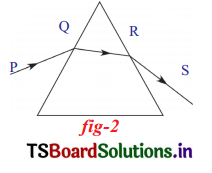
(A) PQ is horizontal Q
(B) QR is horizontal
(C) RS is horizontal
(D) either PQ or RS is horizontal
Answer:
Question 5.
Far point of a person s 5m. In order that he has normal vision what kind of spectacles should he use? ( )
(A) concave lens with focal length 5 m.
(B) concave lens with focal length 10 m.
(C) convex lens with focal length 5 m.
(D) convex lens with focal length 2.5 m.
Answer:
Question 6.
The process of re-emission of absorbed light in all directions with different intensities by the atom or molecule is called ( )
(A) Scattering of light
(B) dispersion of light
(C) reflection of light
(D) refraction of light
Answer:
Suggested Experiments
Question 1.
Conduct an experiment to produce a rainbow in your classroom and explain the procedure.
Answer:
What you’ll need:
A glass of water (about three-quarters full) White paper, A sunny day
Instructions:
- Take the glass of water and the white paper to a part of the room with bright sunlight (near a window is good).
- Hold the glass of water (being careful not to spill it) above the paper and watch as sunlight passes through the glass of water, refracts (bends) and forms a rainbow of colors on your sheet of paper.
- Try holding the glass of water at different heights and angles to see if it has a different effect.
What’s happening?
While you normally see a rainbow as an arc of color in the sky, they can also form In other situations. You may have seen a rainbow in a water fountain or In the mist of a waterfall and you can even make your own such as you did in this experiment.
Rainbows form in the sky when sunlight refracts (bends) as it passes through raindrops. It acts in the same way when It passes through your glass of water. The sunlight refracts, separating It into the colors red, orange, yellow, green, blue, indigo and violet.
Question 2.
conduct an experiment to find the refractive Index of a prism.
Answer:
Aim: Finding the refractive index of a prism.
Material required: Prism, piece of white chart of size 20 x 20 cm, Pencil, Pins, Scale and Protractor.
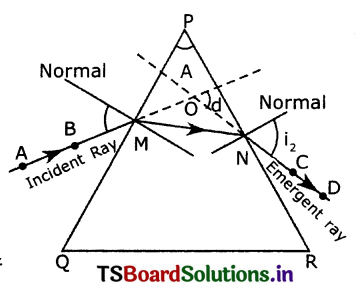
Procedure:
- Take a prism and place it on the white chart in such a way that the rectangular base of the prism is on the chart.
- Draw a line around the prism (boundary) using a pencil. Remove the prism.
- You will get a triangle and name Its vertices as P, Q and R.
- The angle between the surfaces PQ and QR Is called angle of the prism (A).
- Make M’ on the side of triangle PQ and also draw a perpendicular to PQ at “M’
- Draw a line AB making an angle of 30° with the normal which represents incident ray and this angle is called angle of Incidence.
- Place the prism in its position again. Now fix two pins vertically on the line at ‘A’ and ‘B’ as shown in fig.
- Look for the images of pins through the prism from the other side (PR) and another two pins ‘C’ and ‘D’ in such a way that all the four pins appear lie along the same straight line.
- Now remove the pnsm and take out pins. Now join the two pin-holes formed by the pins to meet surface PR at N.
- This Is called emergent ray and the angle between the normal at N and emergent ray is the angle of emergence (i2). Measure this angle and note down In the table.
- Extend both incident and emergent ray till they meet at a point ‘O Measure the angle between these two rays. This Is the angle of deviation (d).
- Repeat this procedure for various angles of incident such as 40°, 5O° 60° etc. Find the corresponding angles of deviation and angles of emergence and note them in the following table.
| Angle of incidence (i1) | Angle of emergence (i2) | Angle of deviation (d) |
l-d Graph:
1) Take the angle of Incidence along X – axis and the angle of deviation along Y – axis. You will get a U – shaped graph.
2) From the graph identify the angle of incidence (i1) for which the angle of deviation is minimum. Note this point as ‘D’ on the Y – axis which Is called angle of minimum deviation (D).
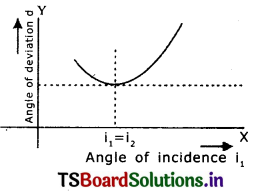
Now refractive index of the prism can be calculated using formula
n = \(\frac{\operatorname{Sin}\left(\frac{A+D}{2}\right)}{\operatorname{Sin} A / 2}\)

![]()
Question 3.
Conduct an experiment to demonstrate the scattering of light.
Answer:
Required material: beaker, sodium-thiol-sulphate (hypo), sulphuric acid, water.
- Take a solution of sodium-thio-sulphate (hypo) and sulphuric acid in a glass beaker.
- Place the beaker in an open place where abundant sunlight is available.
- Watch the formation of grains of sulphur and observe changes in the beaker.
- Sulphur precipitates as the reaction Is in progress.
- At the beginning, the grains of sulphur are smaller In size and appear blue in colour. As the reaction progresses, the size of grains increases and slowly their colour becomes white.
- At the beginning, the size of grains is small and almost comparable to the wavelength of blue light. Hence they appear blue.
- As the size of grains Increases, their size becomes comparable to the wavelengths of other colours and these grains act as scattering centres for other colours.
- The combinations of all these colours appears as white.
Suggested Projects
Question 1.
Prisms are used in binoculars. Collect Information why prisms are used In binoculars.
Answer:
- Binoculars are two identical telescopes placed side by side to each other.
- At front side of each telescope Is a lens, called the objective lens. Its role is to gather light from whatever you are looking at and bring It to a focus in the eyepiece, where the light is formed into a visible image and magnified to take up a large portion of the retina.
- The image produced by this telescope will be upside down and backwards.
- This Is why binoculars use corrective elements between the objective and the eyepiece, called prisms.
- Prisms used in binoculars are blocks of glass that function as mirrors but without a mirror’s reflective backing.
- Their role is to bring the light beams from the objective closer together by means of internal reflection and also turn the image right-side up and orient the view properly left to right.
- The diagram shows the path of the light that enters the objectives, passes through a set of prisms that turn the image right side up and finally leave the eyepiece to enter the observer’s eye. This applies to all binoculars.
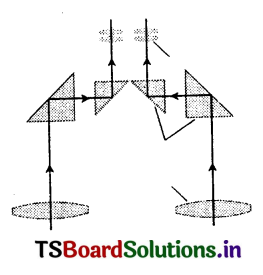
Question 2.
Collect the information about different types of eye defets from your nearest eye specialist or optical shop and write a report.
Answer:
There are many eye related problems and defects of the eye which are cadue to the loss of ability of accommodate of eye lens. Some of these discussed below :
Defects of the eye:
| Name of the eye defect | About this defect | Reason for cause of this defect |
| 1. Myopia | This is a defect of vision in which distant object appears blurred but near objects are seen clearly. |
This defect is caused due to the eye ball becoming too long or the refractive power of the eye’s lens is too strong. |
| 2. Hypermetropia | This Is a defect of vision In which a person cannot see near vision but can see distant objects clearly. | This occurs when the eye ball is contracted or the refractive power of the lens Is too weak. |
| 3. Astgmatism | This defect occurs when the light rays do not come to a single focal point on the retina, Instead some focus on the retina and some focus In front or behind it. | This is usually caused by a non-uniform curvature of the cornea. |
| 4. Presbyopia | It is that defect of vision due to which an old person cannot see the nearby objects closely due to loss of power of accommodation of eye. |
This is due to ciliary muscles becoming weak and the eye lens becoming inflexible. |
1. Eye-Related Problems:
| Name of the problem | Description | Reason for the cause of this probelm |
| 1. Cataract | A cataract is a clouding of the lens, which prevents a clear, sharp image being produced. |
A cataract formed because the lens is selected in a capsule and as old cells die they get trapped in the capsule, with time this causes a clouding over the lens. |
| 2. Age-related macular degeneration (ARMO) | This is a degenerative condition of the maculd (the central retina) | It is caused by the hardening of the arteries that nourishes the retina. |
| 3. Glaucoma. | The eye produces a clear fluid (aqueous humour) that fills the space between the cornea and the Iris. It Is the balance between the production and drainage of this fluid that determines the eyes intraocular pressure (IOP) |
Glaucoma is a discase caused by increased lOP usually resulting from a malfunction Is the eye’s drainage sytem. |
![]()
Question 3.
Collect the different types of lenses used for correcting the eye defects and write a report.
Answer:
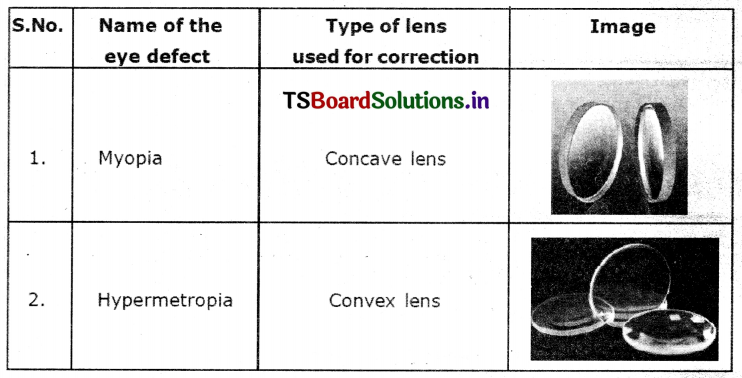
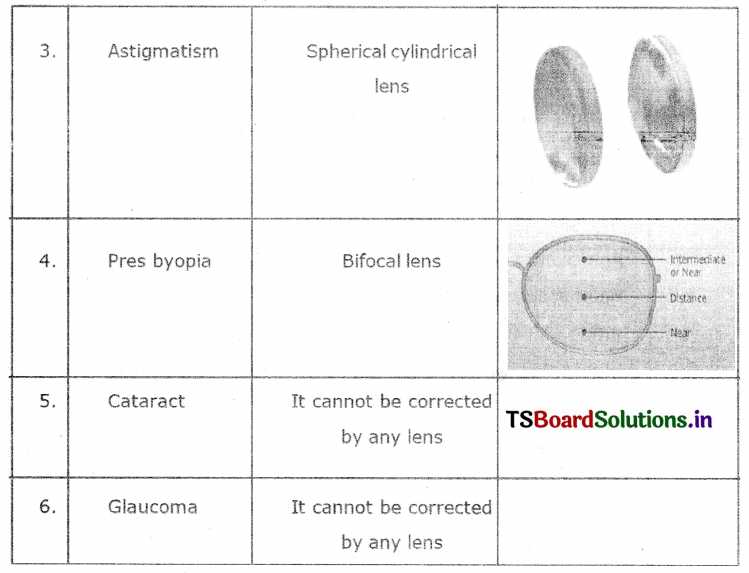
Non – a – days so many people are using contact lenses in the place of above-mentioned lenses. There are two types of contact lenses in use. They are
- The rigid, gas-permeable lens.
- The soft, water-absorbing lens.
Question 4.
Collect the information about the dispersion phenomenon occurs in the daily life.
Answer:
In the year 1665, Newton discovered by his experiments with glass prisms that white light (like sunlight) consists of a mixture of seven colours. Newton found that if a beam of white light is passed through a triangular glass prism, the white light spits to form a band of seven colours on a white screen.
Dispersion: The splitting up of white light into seven colours on passing through a transparent medium like a glass prism is called dispersion of light.
Examples for dispersion phenomenon in daily life:
(a) Formation of Ralnblow:
- One of the most beautiful examples of spectrum formed by the dispersion of sunlight Is provided by nature in the form of rainbow.
- The rainbow is actually a nature spectrum of sunlight in the sky.
- The rainbow is formed in the sky when the sun is shining and it is raining at the same time.
- We can see the rainbow if we stand with our back towards the sun and rain Infront of us. A rainbow is always formed is a direction opposite to that of the sun.
- A rainbow is produced by the dispersion of white sunlight by raindrops in the atmosphere.
- The raindrops in the atmosphere act like many small prisms.
- As white light enters and leaves these raindrops, the various coloured rays present in white light are refracted by different amounts due to which an arch of seven colours called rainbow is formed in the sky.
(b) Another example for dispersion of light In daily life are:
- CDs and DVDs disperse the light and produce seven colours.
- The diesel and petrol surface layers which fall on the road also disperse white light and produce seven colours.
TS 10th Class Physical Science Human Eye and Colourful World Intext Questions
Page 83
Question 1.
Why do the values of least distance of distinct vision and angle of vision change with person and age?
Answer:
- The ciliary muscle which attached with eye lens helps the eye lens to change its focal length by changing radii of curvature of eye lens.
- When the eye Is focussed on a distant object, the ciliary muscles are relaxed so that the focal length of eye lens has its maximum value which is equal to its distance from the retina.
- The working of ciliary muscle n eye changes from person to person.
- So, the values of least distance of distinct vision and angle of vision change with person and age.
Page 84
Question 2.
How can we get same image distance for various positions of objects?
Answer:
For different positions of object, the image distance remains constant only when focal length of lens changes.
Question 3.
Can you answer above question using concepts of refraction through lenses?
Answer:
The focal length of a lens depends on the material by which it has been made and radii of curvatures of surface’s lens. We need to change focal length of lens to get same image distance for various positions of object.
![]()
Page 85
Question 4.
How does eye lens changes its focal length?
Answer:
The ciliary muscles to which eye lens is attached help the eye lens to change its focal length by changing radii of curvature of eye lens.
Question 5.
How does this change takes place in eyeball?
Answer:
When the eye is focused on a distant object the ciliary muscles are relaxed and so the focal length of eye lens has its maximum value which ¡s equal to its distance from the retina. The parallel rays coming into the eye are focused on the retina and we see the object clearly.
Question 6.
How does the image formed on retina help us to perceive the object without change in Its shape, size and colour?
Answer:
The eye lens forms a real and inverted image on retina. This retina s a delicate membrane, which contains about 126 million receptors called rods’ and ‘cones. They receive the light signals and identify the colour and the intensity of light. These signals are transmitted to brain through optic-nerve fibres. The brain interprets these signals and finally processes the information so that we perceive the object in terms of its shape, size and colour.
Question 7.
Does eye tens form a real image or virtual image?
Answer:
Eye lens forms a real and inverted image.
Question 8.
Is there any limit to change of focal length of eye lens?
Answer:
Yes, when the object is at Infinity, the parallel rays from the object falling on the eye lens are refracted and they form a point-sized Image on retina. In this situation, eye lens has a maximum focal length.
Question 9.
What are the maximum and minimum focal lengths of the eye lens?
Answer:
Maximum focal length is 2.5 cm and minimum focal length is 2.27 cm.
Page 85
Question 10.
What happens ¡f the eye lens Is not able to adjust its focal length?
Answer:
In this case the person cannot see the object clearly and comfortably.
Question 11.
What happens It the focal length of eye lens is beyond the range of 2.5 cm to 2.27 cm?
Answer:
The vision (image) becomes blurred due to defects of eye lens.
![]()
Page 87
Question 12.
What can we do to correct myopia?
Answer:
To correct myopia, we use concave lens In spectacles.
Page 88
Question 13.
How can you decide the focal length of the lens to be used to correct myopia?
Answer:
Let the object distance (u) is infinity and image distance (v) is equal to distance of far point.
u = -∞’; v= distance of far point = – D
Let ‘f be the focal length of bi-concave lens.
Using the formula : \(\frac{1}{f}=\frac{1}{v}-\frac{1}{u} \Rightarrow \frac{1}{f}=\frac{1}{-D} \Rightarrow f=-D \)
Here ‘f’ is negative for a concave lens.
Question 14.
What happens when the eye has a minimum focal length greater than 2.27 cm?
Answer:
In this case, the rays coming from the nearby object after refraction at eye lens, form image beyond the retina.
Page 89
Question 15.
How can you decide the focal length of convex lens to be used?
Answer:
Here u = – 25
Image distance v = d (distance of near point)
Let ‘f’ be the focal length of bi- convex lens.
Using the formula :
\(\frac{1}{f}=\frac{1}{v}-\frac{1}{u} \)
\(\frac{1}{f}=\frac{1}{-d}-\frac{1}{(-25)} \Rightarrow \frac{1}{f}=\frac{(d-25)}{25 d} \Rightarrow f=\frac{25 d}{(d-25)} \) (f in centimetres)
If d > 25 cm, ⇒ ‘f’ becomes positive then we use biconvex lens to correct hypermetropia.
Page 90
Question 16.
Have you ever observed details in the prescription?
Answer:
A prescription contains some information regarding type of lens to be used to correct vision.
Question 17.
You might have heard people saying “my sight Is Increased or decreased”. What does It mean?
Answer:
Usually, doctors after testing the defects of vision prescribe correcting lenses indicating their power which determines the type of lens to be used and its focal length.
Question 18.
What do you mean by power of lens?
Answer:
The reciprocal of focal length is called power of lens.
Question 19.
Doctor advised to use 2D lens. What is the focal length of it?
Answer:
Given power of lens P = 2D
We know, P = \(\frac{100}{f(\text { incm })} \Rightarrow 2=\frac{100}{f} \Rightarrow f=\frac{100}{2}=50 \mathrm{~cm} \)
Focal length of lens (f) = 50 cm.
Page 91
Question 20.
How could the white light of the sun give us various colours of the rainbow?
Answer:
Due to reflection, refraction and dispersion of sunlight.
Question 21.
What happens to a light ray when ¡t passes through a transparent medium bounded by praise surfaces which are inclined to each other?
Answer:
when light incident on one of the plane surfaces, it emerges from the other.
![]()
Question 22.
What is a prism?
Answer:
A prism is a transparent medium separated from the surrounding medium by consisting two retracting plane surfaces which are Inclined.
Page 92
Question 13.
What is the shape of the outline drawn for a prism?
Answer:
A triangular shape.
Page 93
Question 24.
How do you find the angle of deviation?
Answer:
The angle between the extended Incident and emergent rays is called angle of deviation.
Question 25.
What do you notice from the angle of deviation?
Answer:
The angle of deviation decreases first and then increases with increase of the angle of incidence.
Question 26.
Can you draw a graph between angle of incidence and angle of deviation?
Answer:
Yes, we can draw the graph between angle of incidence and angle of deviation.
Question 27.
From the graph, can you find the minimum of the angles of deviation?
Answer:
Yes we can. Draw a tangent line to the curve, parallel to X – axis, at the lowest point of the graph. The point where the line cuts y-axis cuves the angle of minimum deviation.
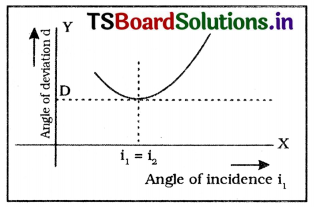
Question 28.
Is there any relation between the angle of incidence (i) and angle of emergence (r) and angle of deviation (d)?
Answer:
(i1+i2) = A+D
i+r = A + D
Page 94
Question 29.
can we derive n = 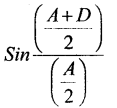 from the equation 5?
from the equation 5?
Answer:
Yes.
From equAtion (3) we get
A + D = 2i2 [since i1 = i2 at angle of minimum deviation (D)]
i2 = \( \frac{A+D}{2}\)
From equation (2) we get
2r2 = A (since r1 = r2 when i1 = i2)
r2 = \(\frac{A}{2} \)
From equation (5)
n sinr2 = sin i2
Substitute i2 = r2 values in (5) we get
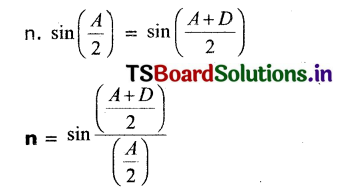
Page 96
Question 30.
In activity-3, we noticed that tight has chosen different paths. does this mean that the refractive index of the prism varies from colour to colour?
Answer:
Yes, refractive index of the prism varies from colour to colour.
Question 31.
Is the speed of light of each colour different?
Answer:
In vacuum – Speed of each colour is constant.
In medium – Speed Is different for different colours.
Question 32.
Can you guess now, why light splits into different colours when it passes through a prism?
Answer:
Due to dispersion of light and different wavelengths of colours in medium.
Page 97
Question 33.
Does It split into more colours? Why?
Answer:
We know the frequency of light is the property of the source and It is equal to number of waves leaving the source per second This cannot be changed by any medium. Hence frequency doesn’t change due to refraction. The coloured light passing through any transparent medium retains its colour.
Question 34.
Can you give an example ¡n nature, where you observe colours as seen In activity 3?
Answer:
Yes, in rainbow. It is a good example of dispersion of light.
Question 35.
When do you see a rainbow ¡n the sky?
Answer:
Due to the refraction, reflection and dispersion of sunlight. When the sunlight passes through the raindrops then we can see the rainbow in the sky.
Question 36.
Can we create a rainbow artificially?
Answer:
Yes, we can create a rainbow artificially.
![]()
Page 99
Question 37.
Why is the sky blue?
Answer:
A clear cloudless day-time sky is blue because molecules in the air scatter blue light from the sun more than they scatter red light.
Question 38.
What is scattering?
Answer:
Atoms or molecules which are exposed to absorb light energy and emit some part of the light energy In different directions and it Is called scattering of light.
Page 101
Question 39.
Why is that the sky appears white sometimes when you view it in certain direction on hot days?
Answer:
In a hot day due to raise of temperature, water vapour enters into atmosphere which leads to abundant presence of water molecules in atmosphere. These water molecules scatter the colours of other frequencies (other than blue). All such colours of other frequencies reaches our eye and white colour is appeared to us.
Page 102
Question 40.
Do you know the reasons for appearance the red colour of sun during sunrise and at sunset?
(Or)
What causes the red colour of sun during sunrise and at sunset?
Answer:
The light rays from the sun travel more distance In atmosphere to reach our eye in morning and evening times. During sunrise and sunset except red colour all colours scatter more and vanishes before reach us. Since scattering of red light is very less, so It reaches us. As a result sun appears reddish during sunrise and sunset.
Question 41.
Can you guess the reason why sun does not appear red during noon hours?
Answer:
During noon hours, the distance to be travelled by the sun rays in atmosphere is less than when compared to morning and evening hours. Therefore all colours reach our eye without scattering. Hence light appears white in noon hours.
Think And Discuss
Question 1.
Can you Imagine the shape of rainbow when observed during travel in an airplane? Discuss with your friends and collect information.
Answer:
When you look at a rainbow from a height high enough so that the sun shines on water particles below you, you will see a full-circle rainbow instead of a horseshoe shape.
TS 10th Class Physical Science Human Eye and Colourful World Activities
Activity 1
Question 1.
How do you find least distance of distinct vision?
Answer:
- Hold the textbook at certain distance with our hands.
- Try to read the contents on the page.
- Gradually move the books towards eye, till it reaches very close to your eyes.
- You may see that printed letters on the page appear blurred or you will feel strain to read.
- Now move the book backwards to a position where you can see clear printed letters without strain.
- Ask your friend to measure distance between your eye and textbook at this position.
- Note down its value.
- Repeat this activity with other friends and note down the distances for distinct vision in each case.
- Find the average of all these distances of clear vision.
- We notice that to see an object comfortably and distinctly, keep it at a distance about 25 cm from your eyes.
- This 25cm distance is called least distance of distinct vision.
- This value vanes from person to person and with age.
Activity 2
Question 2.
How do you measure the angle of vision?
Answer:
1. Collect a few wooden sticks or PVC pipes and make pieces of 20 cm, 30 cm, 35 cm, 40 cm, 50 cm from them.
2. Place a retort stand on a table and stand near the table such that your head is beside the vertical stand.
3. Adjust the clamp on the horizontal rod and fix it at a distance of 25 cm from your eyes.
4. Ask one of your friends to fix a wooden stick of 30 cm height to the damp in a vertical position as shown in the figure.
5. Now keeping your vision parallel to horizontal rod of the stand, try to see the top and bottom of wooden stick kept in vertical position.
6. II you are not able to see both ends of the stick at this instance, adjust the vertical stick on the horizontal rod till you are able to see both ends of the stick, from smallest possible distance from your eye. Fix the vertical stick at this position with the help of the clamp.
7. Without changing the position of the clamp on the horizontal rod, replace this stick of 30 cm length with other sticks of various lengths one by one and try to see the top and bottom of the simultaneously without any change in the position of eye either upwards, downwards or sideways.
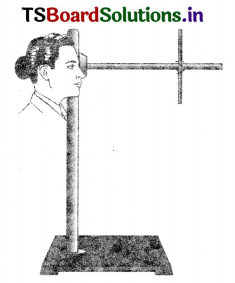
8. From the given figure, you notice that you will be able to see only part EF of the object A and B’ because the rays coming from E and F enter your eye.
9. These rays form an angle at the eye. ¡f this angle is below 60°, we can see the whole object. If this angle is above 60°, then we can see only the part of the object.
10. The maximum angle at which we are able to see the whole object is called angle of vision.
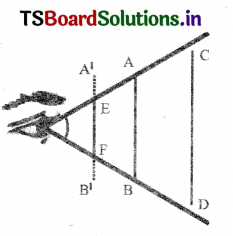
Lab Activity
Aim: Finding to refractIve Index of a prism.
Answer:
Aim: Finding the refractive index of a prism.
Material required: Prism, piece of white chart of size 20 x 20 cm, Pencil, Pins, Scale and Protractor.

Procedure:
- Take a prism and place it on the white chart in such a way that the rectangular base of the prism is on the chart.
- Draw a line around the prism (boundary) using a pencil. Remove the prism.
- You will get a triangle and name Its vertices as P, Q and R.
- The angle between the surfaces PQ and QR Is called angle of the prism (A).
- Make M’ on the side of triangle PQ and also draw a perpendicular to PQ at “M’
- Draw a line AB making an angle of 30° with the normal which represents incident ray and this angle is called angle of Incidence.
- Place the prism in its position again. Now fix two pins vertically on the line at ‘A’ and ‘B’ as shown in fig.
- Look for the images of pins through the prism from the other side (PR) and another two pins ‘C’ and ‘D’ in such a way that all the four pins appear lie along the same straight line.
- Now remove the pnsm and take out pins. Now join the two pin-holes formed by the pins to meet surface PR at N.
- This Is called emergent ray and the angle between the normal at N and emergent ray is the angle of emergence (i2). Measure this angle and note down In the table.
- Extend both incident and emergent ray till they meet at a point ‘O Measure the angle between these two rays. This Is the angle of deviation (d).
- Repeat this procedure for various angles of incident such as 40°, 5O° 60° etc. Find the corresponding angles of deviation and angles of emergence and note them in the following table.
| Angle of incidence (i1) | Angle of emergence (i2) | Angle of deviation (d) |
l-d Graph:
1) Take the angle of Incidence along X – axis and the angle of deviation along Y – axis. You will get a U – shaped graph.
2) From the graph identify the angle of incidence (i1) for which the angle of deviation is minimum. Note this point as ‘D’ on the Y – axis which Is called angle of minimum deviation (D).

Now refractive index of the prism can be calculated using formula
n = \(\frac{\operatorname{Sin}\left(\frac{A+D}{2}\right)}{\operatorname{Sin} A / 2}\)

![]()
Activity 3
Question 3.
Describe an activity for dispersion of light.
Answer:
- Do this experiment In the dark room.
- Take a prism and place It on a table near a vertical white wall.
- Take a thin wooden plank.
- Make a small hole in it and fix it vertically on the table.
- Place the prism between the wooden plank and wall.
- Place a white light source behind the hole of the wooden plank.
- Switch on the light.
- The rays coming out of the hole of plank become a narrow beam of light.
- Adjust the height of the prism such that the light falls on one of the lateral surfaces.
- Observe the changes in emerged rays of the prism.
- Adjust the prism by slightly rotating ¡t till you get an image on the wall.
- We observe a coloured image on the wall.
- The white light s splits into colours because of dispersion.
- We see seven different colours i.e., Violet. Indigo, Blue, Green, Yellow, Orange and Red. (VIBGYOR).
Activity 4
Question 4.
Suggest an experiment to produce a rainbow In your classroom and explain the procedure.
Answer:
- Take a metal try and fill it with water.
- Place a mirror in the water such that it makes
- No: focus white light on the mirror through the water as shown In figure.
- Keep a white cardboard sheet above the water surface. Mirror
- We can observe the colours VIBGYOR on the board.
- The splitting of white light into different colours (VIBGYOR) Is called dispersion.
- So consider a white light Is a collection of waves with different wavelengths.
- Violet has shortest wavelength and red has longest wavelength.
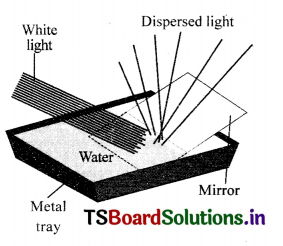
Activity 5
Question 5.
Explain two activities for the formation of artificial rainbow?
Answer:
Activity – I:
- Select a white-coated wall on which the sun rays fall.
- Stand in front of a wall in such a way that the sun rays fall on your back.
- Hold a tube through which water is flowing.
- Place your finger to obstruct the flow of water.
- Water comes from small gaps between the tube and figures like a fountain.
- Observe the changes on wall while showering the water.
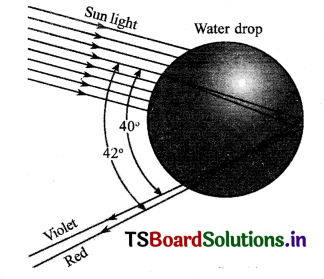
Activity – II :
- Take a metal try and fill it with water.
- Place a mirror in the water such that it makes an angle with water surface.
- Now focus white light on the mirror through the water.
- Keep a white cardboard sheet above the water surface as shown In the figure.
- We may observe the colours VIBGYOR on the board.
- The splitting of white light into different colours (VIBGYOR) is called dispersion.
- So consider a white light is a collection of waves with different wavelengths.
- Violet has shortest wavelength and red has longest wavelength.
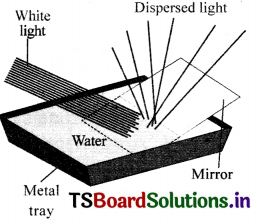
Activity 6
Question 6.
Describe an experiment for scattering of light.
Answer:
- Take a solution of sodium-thin-sulphate (hypo) and sulphuric acid in a glass beaker.
- Place the beaker in an open place where abundant sunlight is available.
- Watch the formation of grains of sulphur and observe changes in the beaker.
- You will notice that sulphur precipitates as the reaction is in progress.
- At the beginning, the grains of sulphur are smaller in size and as the reacton progresses, their size increases due to precipitation.
- Sulphur grains appear blue in colour at the beginning and slowly their colour becomes white as their size increases. Dispensed light
- The reason for this is scattering of light.
- At the beginning, the size of grains is small and almost comparable to the wavelength of blue light.
- Hence they appear blue in the beginning.
- As the size of grains increases, their size becomes comparable to wavelengths of other colours.
- 11. As a result of this, they act as scattering centres for other colours.
- 12. The combination of all these colours appears as white.